“Use 19 Metal Pieces of Approximately the Same Timbre”
An Analysis of Twelve Recorded Performances of Xenakis’s Métaux (Pléïades)
Diederik Mark de Ceuster
The sixxen is a microtonal percussion instrument designed by Iannis Xenakis for Métaux and Mélanges from his 1978 composition Pléïades. The instructions for building this instrument are non-specific; the timbre of the instrument and its specific pitch content are up for the constructor to determine. This has resulted in a number of various sixxen sets used by numerous ensembles that are completely different in their (microtonal) temperament, microtonal pitch series, ambitus, and timbre. This article seeks to explore the aesthetic impact of the indeterminate building instructions of the sixxen by comparing performances of various ensembles and their sixxen sets. Referring both to spectral analysis and the listener’s experience, this article analyzes twelve performances of Métaux for their pitch content and timbre. In the preface to the score of Pléïades, Xenakis describes that the primordial element of the work is rhythm; strong periodic elements are repeated, and then superposed to form “arhythmic clouds of sound.” In comparing the various sixxen sets, this article shows that in some performances the periodic elements are heavily emphasized, whereas in others the sixxens increase the merging of sounds, which de-emphasizes rhythmic structures in favor of so-called “arhythmic clouds.”
Das Sixxen ist ein Schlaginstrument, das Iannis Xenakis für die Sätze Métaux und Mélanges seines 1978 komponierten Zyklus Pléïades entworfen hat. Xenakis’ Bauanleitung lässt offen, welche Tonhöhen und Klangfarben das Instrument produzieren soll. Daher verwenden Ensembles bei der Aufführung dieser Stücke unterschiedliche Sixxen-Sets, die sich in ihrer (mikrotonalen) Stimmung, ihrem Tonvorrat, ihrem Ambitus und ihrer Klangfarbe stark unterscheiden. In diesem Artikel wird die ästhetische Wirkung der unbestimmten Bauanweisungen der Sixxen untersucht, indem Aufführungen verschiedener Ensembles und ihrer jeweils verwendeten Sixxen-Sets miteinander verglichen werden. Mittels Spektralanalyse und unter Bezugnahme auf die Hörerfahrung werden zwölf Aufführungen von Métaux auf ihren Tonhöhengehalt und ihre Klangfarbe hin analysiert. Im Vorwort zur Partitur von Pléïades schreibt Xenakis, dass der vorrangige Aspekt des Werks der Rhythmus sei. Periodische Elemente werden wiederholt und dann zu ›arhythmischen Klangwolken‹ überlagert. Der Interpretationsvergleich ergibt hingegen, dass in einigen Aufführungen die periodischen Elemente stark betont werden, während in anderen Aufführungen die Sixxen die Verschmelzung von Klängen verstärken, wodurch die rhythmischen Strukturen zugunsten dieser ›Klangwolken‹ zurücktreten.
1. Introduction
The agency of an instrument is seldom as tangible as in the case of the sixxen in Iannis Xenakis’s Pléïades (1978). The sixxen is a novel instrument that was specially designed for two of the four movements of this work (Métaux and Mélanges). It is a percussion instrument that consists of nineteen irregularly tuned bars with microtonal steps between the bars. In Pléïades, Xenakis uses six sixxens and notes that besides the microtonal tuning of the complete set of sixxens, there should also be microtonal differences between the six individual instruments themselves. Xenakis left the instructions for the building and tuning of the instrument intentionally indeterminate. This was most likely to accommodate a certain pragmatism on the part of Les Percussions de Strasbourg, who originally commissioned Pléïades, as the ensemble had to work with whatever pieces of metal were available. Over the years, this has resulted, however, in a considerable number of different interpretations of the instrument, as percussion ensembles all over the world have built sixxens to perform Pléïades. As such, there are large differences among the various sixxens, both in terms of pitch distribution and timbre, with some of them sounding so different from each other that they can barely be recognized as the same instrument at all.
These variations between performances of Pléïades, due to the variations in the instruments used by the ensembles, pose major challenges to the music analyst. As both pitch and timbre are largely variable musical elements in this movement, the only constant component suitable for score analysis is its rhythm. And yet, a purely rhythmic analysis would do little justice to the listener’s experience. This would negate the emergent microtonal clusters, the penetrating dissonances, the ever-so pungent metallic sounds heard in so many performances of Métaux. Certainly, these elements, too, constitute an important part of the work as a whole.
Perhaps this is why Métaux and Mélanges have received relatively little analytical attention. While the two other parts of Pléïades (Peaux, written for skinned drums, and Claviers, written for idiophones) have been the subject of compelling structural analyses by Fabrice Marandola and Marie Hortense Lacroix respectively,[1] there are no full analyses for Métaux and Mélanges. Several authors have pointed, however, towards various compositional techniques adopted in these movements, but these discussions are, as one might expect, mainly focused on Xenakis’s rhythmic systems.[2] Instead, to gain a more complete understanding of the agency of the sixxen, this article compares and analyzes twelve recordings, focusing on the pitch distribution and timbral characteristics of the sixxens. The main question to be answered is how these various sixxens impact the musical work, and in particular how they impact the listener’s perception of the rhythmic patterns, as the rhythm is the main constant among all performances.
Borrowing from ‘Actor Network Theory’ (ANT) developed by Bruno Latour, Michel Callon, John Law, and others,[3] I propound the concept of the sixxen as going beyond the function of a mere tool for the musician; instead, it becomes a performative actor that impacts the sounding outcome of this musical work in a direct way. ANT calls for a descriptive methodology, in which human agents and non-human agents are considered equally in the spread of influence. Despite its misleading name, the Actor Network Theory should be viewed as a methodology, and not as a theory. It does not provide a conceptualization of objects or explanations of phenomena. Rather, it provides a set of adaptable questions, focusing on – as the name implies – the networks of an object or idea, but without ever attempting to explain these networks. Key to this approach is to consider the musical work as (in Benjamin Piekut’s term) a “historical ecology,” that is, as an emergent and fluid “web of relations” in which all kind of actors, both human and non-human, impact the sounding outcome in performance.[4]
One such actor could be the performer. Concerning music by Xenakis, research on this dimension includes Christian Utz’s study of the performer’s impact on the perception of time and form in Xenakis’s music,[5] but also comprises multiple essays on the aesthetic ramifications of the chosen performance solutions to technical challenges posed by Xenakis.[6] In this article, I will extend this research by examining the impact of an instrument. Yet, whereas most ANT applications within music studies, including research on instruments, have focused on tracing the history of the actors and their relationships within an ecological system,[7] the present study will not follow that route. With regard to the sixxen, Ronan Gil de Morais, Fernando Martins de Castro Chaib, and Fabio Fonseca de Oliveira have provided a historical overview of all sixxens created so far.[8] In many ways, this article is a continuation of their research, as now the concept of instrumental agency can be taken to the music-analytic level by directly comparing twelve recordings of twelve different sets of sixxens and studying their impact on the musical outcome.
In my comparative study, I will combine a quantitative approach to performance with a qualitative, perception-oriented perspective. This entails a systematic comparison of twelve recordings, with a special focus on four key moments in the piece by gathering data on microtonal pitch distribution and timbral qualities using spectral analysis. However, as the number of samples is relatively small and the variation between the recordings is so large, no statistical analysis has been executed. Rather, the twelve recordings should be seen as a set of case studies that exemplify the extent of the instruments’ agency. Out of these twelve recordings, individual examples have been selected to demonstrate the various aspects in which the instrument impacts the listener’s perception. The quantitative data gathered by Morais et al. and information provided by instrument builder Brett Reed[9] provide the basis for this study. Furthermore, spectral analysis is applied to compare key moments of each recording.
The technology of spectral analysis allows many aspects of performance to be quantified and compared, especially with regard to pitch. This approach was first conceived by Robert Cogan in his book New Images of Musical Sound,[10] in which he explored different uses of spectral images as tools for music analysis. Since then, there have been multiple applications of spectral images in music analysis; however, as Peter Johnson noted, “much of what is shown by spectrographic analysis is little more than a visual analogue of what we have already recognized and perceived through listening.”[11] Hence, the use of spectral images should mainly be seen as a tool for visualizing the analytic method of close listening.[12] In this case, the method of close listening allows us to hear and understand, among other things, the blending of sounds in Xenakis’s Métaux, the forming of clusters, the specific timbral characteristics of the instruments, their consequences for stream segregation,[13] the ability to recognize melodic contours, and, above all, the intelligibility of Xenakis’s composed rhythmic patterns.
Before a comparative analysis between the recordings of Métaux can be made, a rudimentary understanding of the work is warranted. Following Nicholas Cook’s idea of “performance analysis,” a basic analysis of the score is used merely as a reference for comparing the musical structures that arise in performance,[14] not with the intention to map the presented interpretations onto “a prefabricated structural conception that is based on the score,”[15] but instead to focus on those elements not specified in the score (in this case the tuning of the instruments, the ambitus, the timbre) and investigate how these relate to, and effectively transform, that which is presented in the score. I will thus start with a heuristic description and segmentation of Métaux, and explicate the rhythmical structures as determined by the score of Métaux. Then, I will compare the different tunings of each recording and their aesthetic impact on Métaux, including the role of ambitus. Finally, I will discuss the impact of the various timbres among the twelve compared recordings, which produce an incredibly wide range of different sounds, even though they are all metallic.
2. The Rhythmic Material of Métaux
In his analysis of Peaux, one of the other three movements of Xenakis’s Pléïades, Marandola describes the formal structure of this movement as consisting of eight separate sections, each strongly contrasting with one another.[16] The form of Métaux is similar; however, there are fewer sections and the segmentation of Métaux is slightly less defined, as the sections are more merged into each other. Five main sections and a coda can be identified based on the basic changes in texture and rhythmic articulation. As in Peaux, and the two other movements of Pléïades, each section is built by establishing a certain periodicity, such as a repeated rhythmic phrase which gradually increases in complexity until the initial periodic layer is no longer distinguishable (for example by separating the ensemble in various tempi). At a certain point, the composer abruptly shifts to a new layer of periodicity, such as a different rhythmic phrase, which signifies a new section of the movement. Sections I, II, IV, and V contain sub-sections, as one periodic element of a section is continued in the next but now superposed on different musical material.
Table 1: Segmentation of Métaux (Pléïades) by Iannis Xenakis (1978)
To understand the rhythmic material presented in Pléïades, it is worth looking at Xenakis’s preface to the score. He emphasizes that the “primordial element [of Pléïades] is rhythm,” which he further describes as “the ordering in time of events, the combination of durations, intensities, timbres.”[17] He goes on:
It is constructed in several parallel fields but with transverse circulations, i. e. figures are simultaneously deformed or not as the case may be. Some of the fields are made manifest by accents which superpose rhythms onto the normal beat. […] The sole source of this polyrhythm is the idea of periodicity, repetition, duplication, recurrence, copy, faithfulness, pseudo-faithfulness. For example, a beat incessantly repeated with the same pattern represents a faithful copy of a rhythmic atom. […] In this way, small variations in the pattern produce internal rhythmic activity without damaging the fundamental period. Greater and more complex variations of the initial period create a disfiguration which may lead to immediate non-recognition. More diverse variations, of still greater complexity or (which often comes to the same thing) resulting from the chance distribution of a particular stochastic procedure leads to total arhythm, to a knowledge through mass of events, to notions of clouds, nebulae, dust galaxies of rhythmically organized beats. Moreover, the speeds of these transformations create new disfigurations superposed upon the preceding, ranging from little continuous accelerations to rapid, not to say exponential transformations (still continuous) which sweep the listener along like a whirlwind, dragging him as though to inevitable catastrophe or to a contorted universe. Again, infinitely great speeds, corresponding to brutal breakings-up of the transformations, move instantaneously from one kind of evolution to another of an essentially different type.[18]
Throughout Pléïades, polyrhythm, as described in the above quote, is chiefly created by the superposition of different speeds. In the score, this is realized by having the same rhythmic pattern played by one of the six percussionists duplicated by another, but now written in tuplets. At the opening of Métaux one can find this polyrhythm in its most rudimentary form as the six percussionists play a regular beat in unison. From the middle of bar 2, a 5:4 cross-rhythm is superposed, splitting the ensemble into two different speeds, before adding a third, fourth, and fifth speed in quick succession (see Ex. 1). The percussionists then merge into a single 1:1 unison of the rhythmic atom again, before another spread of velocities occurs.
Example 1: Métaux (Pléïades) by Iannis Xenakis (1978); succession of different speeds in the opening bars (mm. 1–7)
In this example, the idea of a gradual complication of a rhythmic pattern is very plain. When the first cross-rhythm is introduced in bar 2, the initial periodic beat is still clearly perceptible, but as soon as more tuplets are introduced, individual pulses become indiscernible from each other and instead we hear a mass of non-rhythmic beats.
A more advanced version of the same principle is presented in bars 134–153 (see Ex. 2). Here the percussionists first play in a rhythmic unison with the ensemble split in two voices, when suddenly each of the six players continues at a different pace. Moreover, here we can see how the composer applied his “more diverse variations, of still greater complexity,”[19] as each player performs a similar line – consisting of multiple scales, starting with small undulations and ending in a couple of waves that span the full register of the instrument – but with each percussionist playing a different series of pitches and a different number of notes. For example, starting at the fourth beat of bar 134 player A takes twenty-one hits to go from the lowest to the highest note, while player D (who is already playing at a faster pace) only takes seventeen notes to get to the top. The result is that not only do individual lines become indiscernible from each other, but that the peaks and valleys of the scales occur at different moments in time, creating a fully non-synchronized cluster of sound.
Example 2: Métaux (Pléïades) by Iannis Xenakis (1978); non-synchronization in mm. 134–136
At other times, complex rhythms are superposed on a steady, rhythmic background. For example, in bars 157–168, four of the six percussionists perform a simple rhythmic pattern in regular meter, and all six percussionists stress every quarter note with a hit on the lowest note on the instrument (see Ex. 3). In the meantime, percussionists C and D perform various rhythmic motives in irrational values, that is, in tuplets of 9:7, 6:5, 7:6, etc. As Ann-Sylvie Barthel-Calvet has pointed out, the two phrases are very close to each other in terms of relative speed, yet due to the constant speeding up and slowing down resulting from the tuplets, the individual rhythms are truly hard to perceive.[20] Instead, this fragment as a whole appears as two layers of percussion, one of which is in clearly defined quantified time, and the other in a seemingly random organization of beats in time.
Example 3: Métaux (Pléïades) by Iannis Xenakis (1978); two layers in mm. 157–159
Finally, Xenakis has placed a number of small irregularities to disturb the sense of rhythm, such as the irregular lengths of the beats in bars 35–65 by players B–F, the subtle difference between the rhythmic motive of Player A and Player E in bar 78 or the thirty-second rest at the start of bar 89, misplacing the motive from the expected beat.
Throughout Métaux one can hear different forms of rhythms, ranging from strong rhythmic patterns in unison, to strong patterns with subtle but stark irregularities, to a superposition of clear rhythmic periodicities and non-synchronized rhythms, to fully non-synchronized clusters.[21] Now that the basics of Xenakis’s rhythmic treatment have been sketched, we can examine how the sixxens impact these various forms of rhythm.
3. The Sixxen: A Comparative Analysis
The full account of Xenakis’s instructions for building the sixxens are as follows:
[Use] 19 metal pieces (made of brass, or steel, etc.) of approximately the same timbre. It is highly desirable that the timbre be a really interesting metallic one. By interesting I mean astounding, strange, full, resounding and without too much reverberation so that the minute rhythmical patterns can be clear for the audience. These 19 metal pieces should be tuned to produce 19 pitches which should absolutely not form an equally tempered scale. The whole range of 19 pitches is arbitrary and should depend on the available pieces. However, this range should be nearly the same for all the six percussionists and placed within the same extremes of pitch. This means that for any given pitch out of the 19, and for any of the six SIXXENS, the other 5 corresponding ones must not form unisons. The deviation could be slight but should still be noticeable. […] In my score, the notation is fictitious, that is, it does not correspond to real pitches, it is only a way of identifying graphically each of the 19 different pitches of each SIXXEN.[22]
As Morais et al. have pointed out, these instructions have very few specifications and leave innumerable possibilities of interpretation.[23] In Table 2, an overview is presented of the compared recordings. These recordings have been chosen based on available data to form a divergent group of instruments.[24]
Table 2: List of selected recordings of Métaux (Pléïades) by Iannis Xenakis (1978)
These instruments, seen from the viewpoint of the ‘Actor Network Theory,’ have affordances that allow the musicians to create their performance in a particular way. An affordance is a characteristic that enables, or even encourages, certain interactions and prevents or frustrates others.[25] The tuning of the sixxen is the first and foremost feature in which the complexity of the sound structures can be increased relative to an imaginary rendition of the same music in equal temperament. The exact instructions given by the composer indicate that nineteen metal pieces of neighboring, ascending tones (in terms of pitch) should be used. However, the nineteen pieces should not form equally tempered chromatic or diatonic relations. Instead, the nineteen pitches are fully arbitrary and should depend on the available pieces. Moreover, Xenakis indicates that for any given piece of metal, the six instruments will only roughly give the same pitch. That is, there should be microtonal fluctuation between the six percussionists when they play in a notated perfect unison. Xenakis recommends that taken two by two, the distance between two instruments can be up to three quarters of a tone.[26] The percussionist Brett Reed, who constructed the sixxens for the Red Fish Blue Fish percussion ensemble, interpreted this to mean that “Adjacent pairs of sixxen (i. e. player A and B, B and C, etc.) should not have any notes in perfect unison,”[27] yet in a different edition Xenakis mentions that “for any given pitch out of the 19, and for any of the six SIXXENS, the other 5 must not form unisons.”[28] Regardless of these slight discrepancies in the composer’s instructions between different editions of the score, more significant elements for the construction of the instrument are fully left at the discretion of the instrument builder (such as its timbre and relative ambitus). In Table 2, some of these choices (i. e. the material and shape of pieces of metal and the choice to include pedals and/or resonating tubes) have been outlined for each of the recordings that will be compared. Following from this, in comparing the sound of the various sets of sixxens, the instruments can be distinguished from each other from the perspective of two categories: pitch (including ambitus) and timbre. With regard to pitch, both the microtonal tuning of the nineteen pitches per instrument is considered as well as the microtonal fluctuation between the six instruments. Ambitus is measured by looking at the relative register of the instruments, comparing the pitch of the opening note (a lower opening note means that the instrument is situated in a lower register). Timbre, lastly, is described using spectral images and aural impressions to distinguish sounds by their noise content and time envelope.
There are other factors not listed here that impact both the timbre and the pitch of the instruments, yet most of these are attributable to the performance of the percussionists, rather than to the qualities of the instrument. Loudness is of particular importance. As Philippe Manoury pointed out in his discussion of the sixxens,
As in any struck instrument, dynamic variations resonate different spectral densities: a low-intensity sound will have only a few partials while a high-intensity sound will bring out a large number. In the case of sounds with strong harmonicity (such as piano or marimba for example) the sensation of pitch will not vary with the dynamic level since harmonic nature will remain the determining element for the perception of the fundamental pitch (the principle of spectral fusion). In the case of sixxens, because of their strong inharmonicity, the variations of intensities will bring out partials that will not merge with any fundamental pitch; on the contrary, they will produce additional ‘colors’ that are foreign to the spectrum of the same note played in a weak dynamic. The sensation of pitch will therefore vary according to the attack levels of the sounds.[29]
In Diana Coole’s “new materialism,” agency is described not as an essential characteristic, but rather as emergent “contingent capacities for reflexivity, creative disclosure and transformation.”[30] This is how we can understand the sixxen too. The instrument gives a potential field of possibilities for the musician and the sounding outcome will always be the result of a dialogue between musician and material. Since the only data available for this case study that can be analyzed are the recordings of the performances of Métaux, the instrument and its performer cannot be fully separated. Hence, the reader should be aware that the comparative analysis below is not a comparison between various sixxens per se, but rather a comparison between different recorded performances, in which the choice of the respective sixxens is selected here as the most significant element within these different interpretations.
3.1 The Microtonal Tuning of the Nineteen Pitches per Instrument
In the score of Métaux, Xenakis made use of nineteen notated pitches from F4 to B5. These pitches, however, do not correspond with the actual pitches of the instrument which are, as stated above, for the instrument builder to determine. Following from this description, it can be deduced that microtonality in Métaux is constituted in two ways. First of all, each of the six instruments is tuned in a (non-systematic) microtonal key, i. e. the nineteen pitches are separated by microtonal differences. Secondly, there is microtonal fluctuation between the six instruments, i. e. for each of the nineteen pitches there is a microtonal difference between the instruments. These two forms of microtonality impact the music in different ways, and thus will be discussed separately here, starting with the microtonal tuning of the nineteen pitches per instrument. From the recordings alone, it would be extremely difficult, if not impossible, to extrapolate the exact tunings of the nineteen pitches per instrument for each of the recordings. To do so, each of the nineteen pitches would have to be presented in isolation by the same instrument throughout the recordings, but the composer has not written the music in such a way. The percussionist Brett Reed, however, provided insight into a possible tuning of a sixxen through his description of the building process for a set of sixxens for the Red Fish Blue Fish percussion ensemble:
Table 3: Example of a possible tuning of a single sixxen;[31] C4 is equal to Middle C, ¢ refers to cents, one equal tempered semitone is equivalent to 100 cents
The first thing to notice from this set of pitches is that it would be impossible to form an analysis of harmonic structures for this complete set as the intervals from one pitch to the next vary greatly (the largest interval being 285¢, or close to three semitones, and the smallest interval 50¢, or one quarter-tone). However, in comparing this set of pitches to the distribution of pitches as they are notated by Xenakis in Métaux, there are some interesting results. For example, in bars 18–33 there is an accompanied solo in the high register played by one percussionist in which, throughout all of its development, only a series of variations of three notated pitches is heard: G5, A5 and B5 (see Ex. 4).
Example 4: Métaux (Pléïades) by Iannis Xenakis (1978), mm. 35–38
Due to the way the sixxen used by Red Fish Blue Fish is tuned, these notes form an almost completely diatonic relationship, as the relative distance of these notated pitches are exactly one semitone (from the notated G5 to the notated A5) and three semitones (from the notated A5 to the notated B5) with an inconsequential difference of -10¢. Perhaps this is an example of Reed’s determination to choose a set that “is interesting in its melodic shape that also conforms to the guidelines that Xenakis has laid out,”[32] but more importantly it creates more contrast between the foregrounded solo and the accompaniment. This accompaniment, which is already separated from the solo by its relative register, is now also different in terms of pitch structures. As the two notes played by the other five percussionists form an irregular interval of 755¢, it contrasts with the purely diatonic structures of the high register solo. Compare this short segment played by Red Fish Blue Fish (see Video Ex. 1)[33] for example to the same segment played by So Percussion and Meehan / Perkins Duo (see Video Ex. 2) in which the accompanying two notes are relatively close to an interval of a minor third, while the high register has much more microtonal tension.
Video Example 1: Métaux (Pléïades) by Iannis Xenakis (1978), mm. 35–38; Xenakis, Red Fish Blue Fish, conducted by Steven Schick, Mode Records, Mode 171/73, ℗ 2006, CD 2, track 3, 02:31–02:45
Video Example 2: Métaux (Pléïades) by Iannis Xenakis (1978), mm. 35–38; So Percussion and Meehan / Perkins Duo. 2011 (Live recording, Indianapolis, IN, 10 November 2010). https://youtu.be/GuWmpEI4_oI, 02:53–03:05 (8 Jun 2021)
Another example of ordered pitch structures in the tuning of this sixxen can be found in the middle register: from the notated C5 to F
5 all intervals are very close to a semitone (within 20¢ or less). This means that when these middle notes are frequently played, one is able to hear intervals that closely resemble the pitch space of an equal-tempered instrument. For example, in bars 72–74 (see Ex. 5) there is a fast descending and ascending line played by all percussionists in unison, which is notated as a largely chromatic scale.
Example 5: Métaux (Pléïades) by Iannis Xenakis (1978); chromatic figure in mm. 72–74
As so many notes played in this line fall between C5 to F
5, this passage in the recording of Red Fish Blue Fish (see Video Ex. 3) results in a remarkably chromatic sound-object, albeit with a more complex timbre that is “ringing out of tune” due to microtonal differences between the six instruments. For other recordings this wave-like figure is far more stretched, indicating a tuning of intervals larger than a semitone (see for instance the recordings of Kroumata Percussion Ensemble, Video Ex. 4, and of Synergy Percussion, Video Ex. 5). And for yet other ensembles, this fast up-and-down line appears much flatter in the spectral images. For example, in the recording by Decibells (see Video Ex. 6) this series of notes, which in the notation moves from G
5 down to C5, in the recording barely covers a range of three semitones. This does not give a “chromatic” impression at all, but rather it affords us to hear a continuous series of notes with only subtle, microtonal variations.
Video Example 3: Métaux (Pléïades) by Iannis Xenakis (1978), mm. 72–74; Xenakis, Red Fish Blue Fish, conducted by Steven Schick, Mode Records, Mode 171/73, ℗ 2006, CD 2, track 3, 05:16–05:31
Video Example 4: Métaux (Pléïades) by Iannis Xenakis (1978), mm. 72–74; Iannis Xenakis, Kroumata Percussion Ensemble, conducted by Gert Mortensen, BIS, BIS-CD-482, ℗ 1990, track 1, 04:52–05:05
Video Example 5: Métaux (Pléïades) by Iannis Xenakis (1978), mm. 72–74; Xenakis: Pleiades, Synergy Percussion, Not On Label, SCRA20161, ℗ 2016, track 1, 06:12–06:24
Video Example 6: Métaux (Pléïades) by Iannis Xenakis (1978), mm. 72–74; Pléïades by Iannis Xenakis, Decibells, Genuin, GEN 19633, ℗ 2019, track 3, 05:23–05:37
3.2 Microtonal Fluctuation between Instruments
The second type of microtonality is the fluctuation between the six instruments for any given pitch. According to Xenakis, “the deviation could be slight but should be still noticeable.” Brett Reed indicated in his notes on constructing a set of sixxen that here Xenakis meant three quarters of a semitone, in other words a maximum of 75¢. In practice, however, there is large variation between the various performances with regards to these tunings, with some ensembles presenting a difference of more than a semitone and others presenting almost no noticeable fluctuation. Using Sonic Visualizer’s spectrum analysis, an approximation of this pitch range per recording can be made (see Table 4).[34] Here, a pitch range of 100¢ indicates that all six instruments are tuned within 100¢ (one semitone) of each other.
Table 4: Approximation of microtonal fluctuation for the opening measure of Métaux (Pléïades) by Iannis Xenakis (1978)
This form of microtonality impacts the work in two ways. Firstly, notated unisons can have an effect of dissonance. Secondly, it can have an effect of incongruity when one motive, line or segment is played by one instrument and then repeated by another. Starting with the first, this microtonal dissonance can be understood as a “roughness” of tone. Between two tones, we can find that more sensory “roughness” appears if the two tones have a more complex ratio in frequency between them as the complexity of the resulting fluctuations between the overtones of the two tones increases. In a simple ratio, for example, 3:2 in a dyad of a perfect fifth, the overtones are in phase with each other, but in the more complex ratio of say, a minor second (16:15) the overtones of the two fundamental tones fluctuate in amplitude, creating a series of beats heard between the two tones.[35]
With microtonality, in particular a non-systematized microtonality such as here, this kind of dissonance is taken to the extreme, and we can speak of a constant fluctuation (as displayed in Table 4). If we now compare the opening of Métaux, we can see and hear how for some recordings there is such a complexity where one can hear “beats” (or in Xenakis’s words where the notated unisons are “ringing false”) and in others, there is very little dissonance in the notated unisons. Compare for example the recordings by Kroumata Percussion Ensemble (the recording with the biggest fluctuation, see Ex. 6 and Video Ex. 7) and the recording by Synergy Percussion (a recording with only minimal fluctuation, see Ex. 7 and Video Ex. 8).
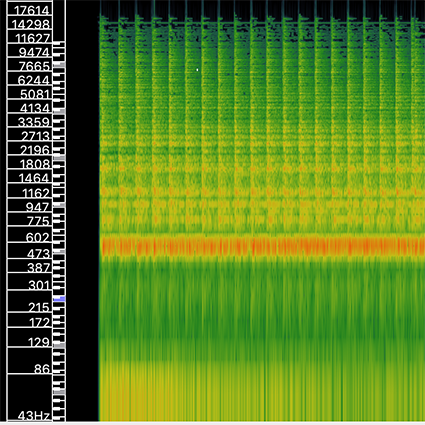
Example 6: Métaux (Pléïades) by Iannis Xenakis (1978), opening measures; Iannis Xenakis, Kroumata Percussion Ensemble, conducted by Gert Mortensen, BIS, BIS-CD-482, ℗ 1990, track 1, 00:00–00:09
Video Example 7: Métaux (Pléïades) by Iannis Xenakis (1978), opening measures; Iannis Xenakis, Kroumata Percussion Ensemble, conducted by Gert Mortensen, BIS, BIS-CD-482, ℗ 1990, track 1, 00:00–00:09
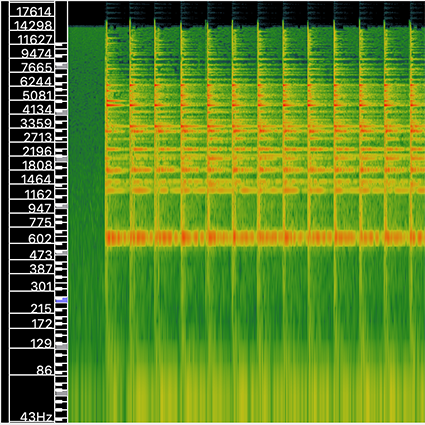
Example 7: Métaux (Pléïades) by Iannis Xenakis (1978), opening measures; Xenakis: Pleiades, Synergy Percussion, Not On Label, SCRA20161, ℗ 2016, track 1, 00:00–00:14
Video Example 8: Métaux (Pléïades) by Iannis Xenakis (1978), opening measures; Xenakis: Pleiades, Synergy Percussion, Not On Label, SCRA20161, ℗ 2016, track 1, 00:00–00:14
For most recordings, the exact microtonal intervals are inaudible as the pitch is masked by the natural noise of the attacks on the metal instruments. What is audible, is the resulting aggregate of harmonics. In the recording by Kroumata, the “dissonance beats” manifest themselves as a thick, sustained layer of sound that is formed on top of the rhythmic hits. It is this layer of sound that further allows us to hear the various instruments as one mass once they start moving at different speeds. In the recording by Synergy, this thick sustained layer is missing. This effect is particularly noticeable when we compare the recordings of two sets of sixxens that are close in terms of timbre and ambitus, but different in their microtonal fluctuation: for example, the recordings by Usine Sonore (see Ex. 8 and Video Ex. 9) and So Percussion and Meehan / Perkins Duo (see Ex. 9 and Video Ex. 10). Adam Sliwinski, who built the sixxens for So Percussion and Meehan / Perkins Duo recalled: “I built the Sixxen for So’s first performance of the full Pleiades back in 2004. Although Xenakis said not to tune unisons among the players, I made each bar quite close – but never the same – so that you can really hear unison textures.”[36]
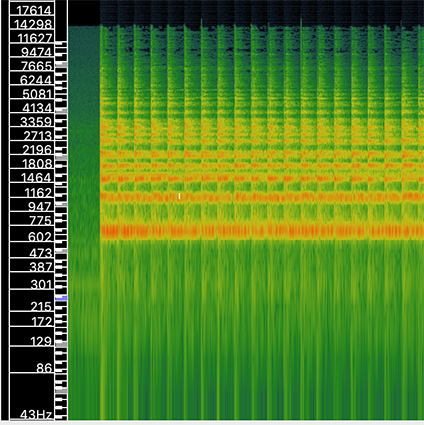
Example 8: Métaux (Pléïades) by Iannis Xenakis (1978), opening measures; Usine Sonore. 2012 (Live recording, Lausanne, 20 March 2012). https://youtu.be/JcNxroY8aOY, 00:00–00:12 (8 Jun 2021)
Video Example 9: Métaux (Pléïades) by Iannis Xenakis (1978), opening measures; Usine Sonore. 2012 (Live recording, Lausanne, 20 March 2012). https://youtu.be/JcNxroY8aOY, 00:00–00:12 (8 Jun 2021)
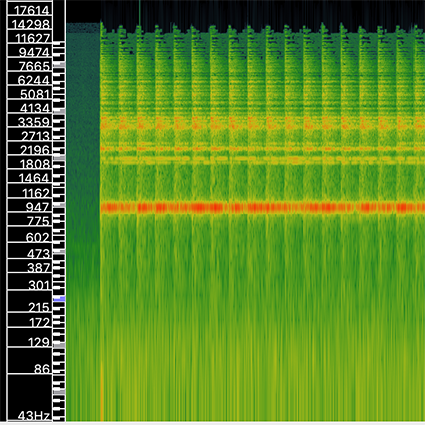
Example 9: Métaux (Pléïades) by Iannis Xenakis (1978), opening measures; So Percussion and Meehan / Perkins Duo. 2011 (Live recording, Indianapolis, IN, 10 November 2010). https://youtu.be/GuWmpEI4_oI, 00:00–00:14 (8 Jun 2021)
Video Example 10: Métaux (Pléïades) by Iannis Xenakis (1978), opening measures; So Percussion and Meehan / Perkins Duo. 2011 (Live recording, Indianapolis, IN, 10 November 2010). https://youtu.be/GuWmpEI4_oI, 00:00–00:14 (8 Jun 2021)
The second way this microtonal fluctuation affects the musical outcome is when musical material is transferred from one instrument to another. This is for example the case in measure 78 (see Ex. 12) in which a rhythmic motive is played by multiple sixxens in quick succession; a motive that gets repeated five times at several points in Métaux. When the instruments are tuned very close to each other, this passage will simply sound as a repetition of a single motive. In the recording by the Yale Percussion Group (see Ex. 10 and Video Ex. 11), when percussionist D plays the motive it sounds like an exact repetition of the motive played one bar earlier by percussionist B. If there would have been a larger difference between the instruments in tuning, this segment might afford an impression of melodic development. This is the case, for example, in the recordings by Synergy (see Ex. 11 and Video Ex. 12).
While for the opening pitch (notated D5) the Synergy recording shows very little fluctuation, it is obvious that for other pitches the instrument builder chose wider microtonal variations. As can be seen and heard from these examples, both the microtonal tuning of one sixxen and the microtonal fluctuation between sixxens affect the complexity of the music, but in different ways. Establishing the microtonal complexity of the various recordings is, however, only the first step in comparing the intelligibility of the rhythmic streams and melodic contours, as both the ambitus and certain timbral elements can either amplify this microtonal complexity, or soften it.
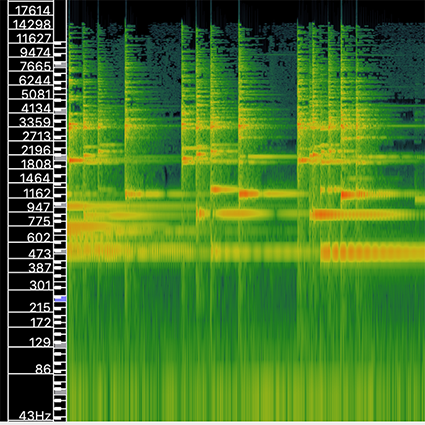
Example 10: Métaux (Pléïades) by Iannis Xenakis (1978); rhythmic motive from mm. 78–79; Yale Percussion Group. 2012 (live recording, New Haven, CT, 22 February 2009). https://youtu.be/Lv3mtQWZVpE, 06:00–06:15 (8 Jun 2021)
Video Example 11: Métaux (Pléïades) by Iannis Xenakis (1978); rhythmic motive from mm. 78–79; Yale Percussion Group. 2012 (live recording, New Haven, CT, 22 February 2009). https://youtu.be/Lv3mtQWZVpE, 06:00–06:15 (8 Jun 2021)
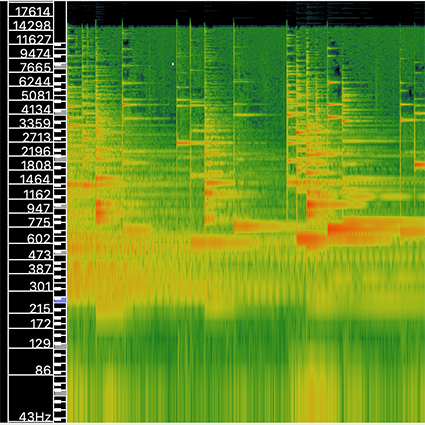
Example 11: Métaux (Pléïades) by Iannis Xenakis (1978); rhythmic motive from mm. 78–79; Xenakis: Pleiades, Synergy Percussion, Not On Label, SCRA20161, ℗ 2016, track 1, 06:35–06:53
Video Example 12: Métaux (Pléïades) by Iannis Xenakis (1978); rhythmic motive from mm. 78–79; Xenakis: Pleiades, Synergy Percussion, Not On Label, SCRA20161, ℗ 2016, track 1, 06:35–06:53
Example 12: Métaux (Pléïades) by Iannis Xenakis (1978); rhythmic motive from mm. 78–79
3.3 Ambitus
The relative ambitus of the sixxens affects the music in a very clear way. Higher frequencies appear to the listener as having greater clarity. This is because lower tones tend to have louder harmonics and tend to blend more into each other. The full ambitus of the sixxens depends of course on the specific pitch distribution, but if we take a look at the relative frequency of the opening pitch we can already make a rough indication of whether the sixxens are tuned in a low or high ambitus. These opening pitches have been presented in Table 4. Here we see that most sixxens tend to be tuned in the fifth octave, with the Les Percussion de Strasbourg and Slagwerk Den Haag in the fourth octave. Of particular interest, however, is the recording by Kuniko Kato, placed in the sixth octave, creating a much clearer sound in which the separate voices can be distinguished much more easily.
3.4 Timbre
In comparing the timbres in the twelve recordings, the first thing one notices is that two ensembles can use the same material and/or shape of the metal bars for their Sixxens, yet create completely different sound textures. Compare for example these recordings by Red Fish Blue Fish (Ex. 13 and Video Ex. 13) and Usine Sonore (Ex. 14 and Video Ex. 14), which have the same material, the same shapes, and the same ambitus.
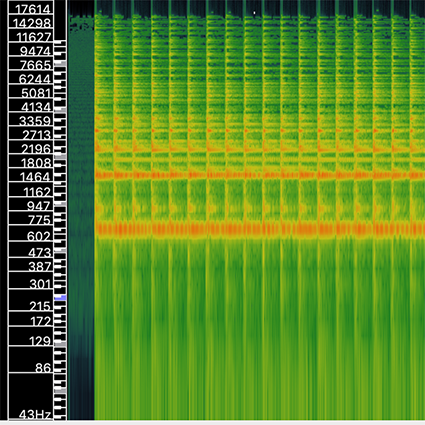
Example 13: Métaux (Pléïades) by Iannis Xenakis (1978), opening measures; Xenakis, Red Fish Blue Fish, conducted by Steven Schick, Mode Records, Mode 171/73, ℗ 2006, CD 2, track 3, 00:00–00:15
Video Example 13: Métaux (Pléïades) by Iannis Xenakis (1978), opening measures; Xenakis, Red Fish Blue Fish, conducted by Steven Schick, Mode Records, Mode 171/73, ℗ 2006, CD 2, track 3, 00:00–00:15
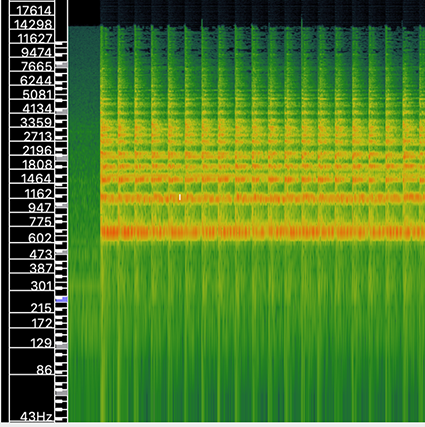
Example 14 (see Ex. 8): Métaux (Pléïades) by Iannis Xenakis (1978), opening measures; Usine Sonore. 2012 (Live recording, Lausanne, 20 March 2012). https://youtu.be/JcNxroY8aOY, 00:00–00:12 (8 Jun 2021)
Video Example 14 (see Video Ex. 9): Métaux (Pléïades) by Iannis Xenakis (1978), opening measures; Usine Sonore. 2012 (Live recording, Lausanne, 20 March 2012). https://youtu.be/JcNxroY8aOY, 00:00–00:12 (8 Jun 2021)
A comparison of these recordings suggests that there is an element of indeterminacy even for the instrument builder. As Haenisch points out in his discussion of Andrea Neumann’s novel instruments, it is such a resistance of the material against letting itself be fully mastered that is indicative of agency.[37] Variations in timbre may be due to the use of different hammers, but it could also be explained by differences in the dimensions of the metal bars, density of the metals, the ways the metal bars are suspended in a frame etc. Because of this, a timbral categorization of the recordings based on the materials and/or shapes of the metal bars is not possible. Instead, one would have to look at the timbre of each recording individually, yet of each of the ways in which the sixxens can be distinguished from each other – pitch, ambitus, and timbre –, timbre is undoubtedly the most difficult to quantify. This is because timbre emerges from a number of different sound elements. According to Stephen McAdams, Philippe Depalle, and Eric Clarke, timbres can be quantifiably distinguished in terms of spectral centroid (i. e. the relative weight of high and low-frequency parts of the spectrum), attack quality, the smoothness of the spectral envelope, the degree of evolution of the spectral envelope over the course of a note, roughness (i. e. the presence of beating and fluctuation between frequencies) and noisiness/inharmonicity.[38] Of these elements, noisiness/inharmonicity seems to be the most relevant for distinguishing the sounds of the sixxen. Between the recordings there is very little difference in attack quality and although there are differences in the smoothness of the spectral envelope and the degree of evolution of the spectral envelope over the course of a note, these do not impact the intelligibility of rhythmic patterns/melodic content in a significant way. There are major differences in the spectral centroid as well, as this measure is mostly related to the perception of brightness. However, here again it would be speculative to argue for a correlation between brightness and the intelligibility of rhythmic patterns or melodic content. Although there is a clear relation between pitch and spectral centroid,[39] it is unclear how this affects the perception of the melodic contours in this specific case study. Roughness is left out here as it has already been discussed in the analysis of microtonality above.
The presence of noise is an element that impacts the perception of pitch, but also influences stream segregation. We can look at the spectrograms of the opening passages to compare the various levels of noise. The noisier a recording, the harder it is to distinguish the microtonal pitches. Compare for example the recording by Impact(o) (see Ex. 15 and Video Ex. 15) with the recording of Decibells (see Ex. 16 and Video Ex. 16).
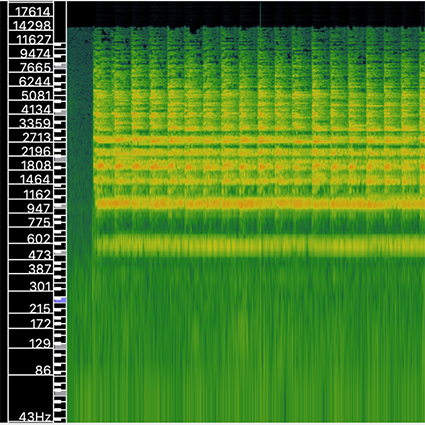
Example 15: Métaux (Pléïades) by Iannis Xenakis (1978), opening measures; Impact(o). 2016 (Live recording, Goiânia, 10 November 2015). https://www.youtube.com/watch?v=zwRW5F3I-Zc, 01:09–01:21 (8 Jun 2021)
Video Example 15: Métaux (Pléïades) by Iannis Xenakis (1978), opening measures; Impact(o). 2016 (Live recording, Goiânia, 10 November 2015). https://www.youtube.com/watch?v=zwRW5F3I-Zc, 01:09–01:21 (8 Jun 2021)
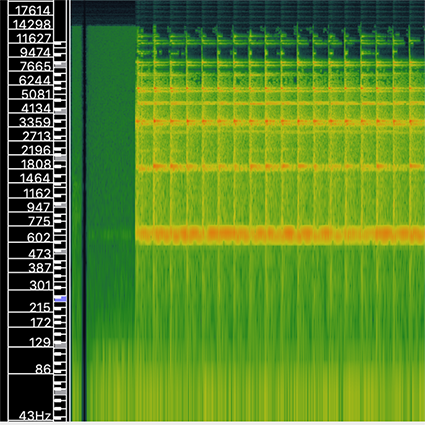
Example 16: Métaux (Pléïades) by Iannis Xenakis (1978), opening measures; Pléïades by Iannis Xenakis, Decibells, Genuin, GEN 19633, ℗ 2019, track 3, 00:00–00:10
Video Example 16: Métaux (Pléïades) by Iannis Xenakis (1978), opening measures; Pléïades by Iannis Xenakis, Decibells, Genuin, GEN 19633, ℗ 2019, track 3, 00:00–00:10
From listening to these openings, one can immediately find that the recording by Impact(o) will sound much harsher and rougher to the ear, with an inherent dissonance due to the irregular overtones. Decibells on the other hand, while presenting similar levels of microtonal fluctuation between the sixxens, sounds much clearer. As soon as new speeds are introduced, these separate streams are therefore much easier to segregate, whereas the noise of Impact(o) functions to merge the sounds together. Noise also creates an effect of blending sounds in the vertical dimension of pitch. This is especially noticeable in the ascending/descending line of Example 5. Here this segment sounds like a large sound mass in the recording of Impact(o) (see Ex. 17 and Video Ex. 17), but like a relatively stable line in the recording of Decibells (see Ex. 18 and Video Ex. 18). Finally, in comparing different timbres, it is common to analyze the attack, sustain, release, and decay of the two tones that are compared. However, as all of the sixxens in all recordings are struck with metal hammers, the attacks will be virtually the same. The decay and release are also less interesting for this analysis. While there may be differences between the instruments, these would hardly impact our perception of complexity. What is of major influence, however, is the level of sustain. If a note has a very long sustain, it means it will still sound when another note is struck. This will result in a blend (think, for example, of playing the piano with or without the right pedal pressed). As can be seen in Table 1, some ensembles have chosen to add resonators to the sixxens (creating a longer sustain), and some have opted for adding pedals to control sustain in certain passages (even though there is no pedal indication in the score).
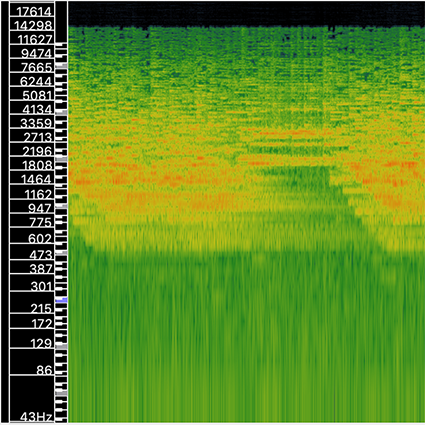
Example 17: Métaux (Pléïades) by Iannis Xenakis (1978), mm. 72–74; Impact(o). 2016 (Live recording, Goiânia, 10 November 2015). https://www.youtube.com/watch?v=zwRW5F3I-Zc, 06:14–06:29 (8 Jun 2021)
Video Example 17: Métaux (Pléïades) by Iannis Xenakis (1978), mm. 72–74; Impact(o). 2016 (Live recording, Goiânia, 10 November 2015). https://www.youtube.com/watch?v=zwRW5F3I-Zc, 06:14–06:29 (8 Jun 2021)
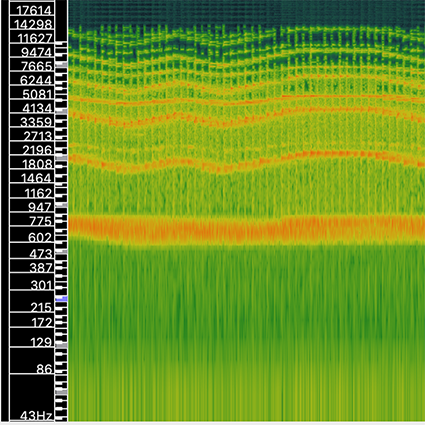
Example 18: Métaux (Pléïades) by Iannis Xenakis (1978), mm. 72–74; Pléïades by Iannis Xenakis, Decibells, Genuin, GEN 19633, ℗ 2019, track 3, 05:23–05:37
Video Example 18 (see Video Ex. 6): Métaux (Pléïades) by Iannis Xenakis (1978), mm. 72–74; Pléïades by Iannis Xenakis, Decibells, Genuin, GEN 19633, ℗ 2019, track 3, 05:23–05:37
The recording by Slagwerk Den Haag, for example, has very high levels of sustain, which blends the descending-ascending figure into a big mass of sound. Especially in the segments in which all six percussionists play at different speeds, this resonance immediately obscures the individual lines. In the recording by Kuniko Kato, on the other hand, both the high ambitus and the relatively low levels of sustain make these individual layers much more intelligible.
4. Conclusions
Although Xenakis specified that the instruments should “ring false,” the range of this microtonal dissonance varies greatly from recording to recording, with the ensembles Impact(o), Usine Sonore, Percurama and Kroumata presenting the largest microtonal intervals (both in terms of the fluctuation between the six instruments, and the sets of chosen pitches for a single sixxen) and Decibells presenting a very narrow range of pitches. Moreover, there are major differences in timbre, with some ensembles presenting very noisy, inharmonic instruments (Impact(o), Percurama), and others presenting a very bright and clear sound (Decibells, Kuniko Kato), some playing with a long reverberating notes (Slagwerk Den Haag, Les Percussion de Strasbourg, Impact(o)), and others with barely any sustain whatsoever (Decibells, Kuniko Kato). Yet, what do these differences tell us with regard to the interpretation of Xenakis’s music?
Each element of the instrument, no matter how small, impacts the intelligibility of the separate streams, i. e., the various rhythmic lines or the various streams of velocities. Brett Reed, in making the sixxens for the Red Fish Blue Fish Ensemble, ensured that for every aspect of the sixxen stream segregation can be maintained as much as possible. As such, the instrument affords the ensemble to create contrast in pitch content between the foreground and the background material at several points in Métaux. Moreover, Reed opted for a tuning that comes relatively close to a diatonic system in several significant passages of Métaux, but he also established a timbre without much resonance to prevent a large blend of sounds and chose a material with little noise content. On the opposite side of the spectrum, there is Impact(o), who chose a set of pitches that is much more irregular, and established a timbre with high noise content. Or there is the recording by Decibells, in which the range of pitches is so minimal that melodic development tends to disappear.
In his analysis of tempi variations among performances of Xenakis’s music, Christian Utz hypothesized that the choices made by the performer when it comes to performance tempo impacts the listener’s perception of form and larger time structures, for example by stressing salient events favoring an interpretation of “spatialized time,” by emphasizing transformative elements favoring an interpretation of “processual time” or by “freezing” in between the salient events to underscore a “presentist time.”[40] A similar claim could be made here, such that higher degrees of intelligibility for stream segregation or hearing melodic contours would suggest a more mosaic-like, segmented form whereas lesser degrees of intelligibility favor an interpretation of a single overarching form as there is a larger blend of sounds in and between segments. However, as the sections contrast so strongly even in the recordings with the densest microtonal pitch distribution (such as the one by Decibells), the various sections are clearly distinctive. What is more important is the development within sections and how these various recordings show different interpretations regarding the intelligibility of rhythmic patterns. If according to the composer, the primordial element of Métaux is rhythm, then some ensembles subvert this element by introducing resonance, noise, and ambiguous pitch.
With the gradual complications of rhythmic structures, Xenakis intended the work to be an exploration of musical perception; an exploration, that is, of the thin borders between hearing complex composite rhythms and hearing a mass of non-rhythmic sounds. And yet the various ensembles performing the work on different sixxens reveal the work to be an exploration on different musical levels as well. With each different sixxen set, the listener is challenged: is one still able to recognize intricate pitch structures or does one simply find thick opaque clusters, due to the strong presence of microtonal harmonics? Can one recognize melodic motives, or is the ambitus so narrow that pitches tend to merge? Can the listener perceive the music as dense texturalization or hear it merely as ambiguous noise? It is here that the agency of the sixxen reveals itself as a material force of potentiality; a transformative affordance that acts in the ecology that we call Xenakis’s Métaux.
Notes
Marandola 2012, and Lacroix 2001. | |
See Harley 2004, 110; Barthel-Calvet 2000, 200–203. | |
Latour 2005, Callon 1986, and Law 1992. | |
Piekut 2014, 212. | |
Utz 2017. | |
See Kanach 2012, Duinker 2012, Nakipbekova 2019, and Solomos 2019. | |
See Haenisch 2013 and Piekut 2014. | |
Morais/Chaib/Oliveira 2017. | |
Reed 2003. | |
Cogan 1984. | |
Johnson 1999, 83. | |
Cook 2013, 135–156. | |
Here ‘stream segregation’ refers to the perceptual process by which we group sounds together into meaningful wholes, allowing us to perceive various voices, or various melodies, that are heard simultaneously. See Bregman 1990, who refers to this process as “auditory scene analysis.” | |
Cook 2013, 49–55. | |
Ibid., 55. | |
Marandola 2012, 187. | |
Xenakis 1978, 2. | |
Ibid., 3. | |
Ibid., 2. | |
Barthel-Calvet 2000, 484. | |
A similar treatment of rhythm can be found in the other movements of Pléïades as well. For example, in Peaux one can find shifts from commetricity to contrametricity, or the technique of superposing different velocities, which Marandola calls “progressively transforming time” (Marandola 2012, 189 and 194). | |
Xenakis 1978, 4. | |
Morais/Chaib/Oliveira 2017, 4. | |
Data gathered from ibid., 15. | |
Gibson 1979, 18. | |
Xenakis 1978, 2. | |
Reed 2003, 48. | |
Xenakis 1979, 4. | |
Manoury 2012, paragraph 3.54, my translation. | |
Coole 2010, 113. | |
Reed 2003, 49. | |
Ibid. | |
In each video example, one can view the spectrogram on the top half of the screen. Here, the y-axis represents time, and the x-axis represents pitch frequency in a logarithmic scale, with indications of Hz and approximate pitch as represented by a piano keyboard on the left-hand side. The color represents the amplitude for each frequency. In order to take the different loudness levels of the various recordings into account, for some recordings the threshold and rotation of color have been slightly adjusted. In the bottom half of the screen, one can view the spectrum for each given time frame. Here, the y-axis represents pitch frequency on a logarithmic scale with indications of Hz and approximate pitch as represented by a piano keyboard at the bottom. The vertical lines highlight the peak frequencies. | |
As these instruments are tuned so closely to each other, it is difficult to establish their exact tunings. On a spectrogram the frequencies of the six instruments will inevitably merge and show up as one fluctuating frequency. This is not necessarily an issue, as in our perception these frequencies also merge into a single sound object. In spectrum analysis the exact frequencies for a given single timeframe are given. It is possible to measure this fluctuation by comparing the peak frequencies from frame to frame for a certain period of time of the recording. For this table, I have measured the peak frequencies of all frames for the first bar of each recording. In theory, a fluctuation of 100¢ would indicate that the six instruments are tuned within that range. In practice, it is unclear how much variation the software picks up; hence it is only an approximation. Moreover, this only shows the fluctuation of the opening notes. It is unclear whether for each recording the same fluctuation applies to all nineteen pitches, as this constraint is not specified by the composer. Whilst the data might not give a precise representation of tunings, it does suffice to demonstrate, in general, the differences in the audible fluctuations in pitch between the recordings and how these fluctuations may impact the music. | |
This description of dissonance as the fluctuation between the harmonics of two tones dates back to the early research on soundwaves and frequencies by Hermann von Helmholtz (Helmholtz 1954, 179–197). Since then, there have been numerous approaches on how to define consonance and dissonance and it is clear that the perception of dissonance differs between cultures, historical periods, and various musical contexts. It should be noted that in this case, I am not referring to the perception of disharmony, but purely to the acoustic effect of “beating” sounds. | |
Engelman 2010. | |
Haenisch 2013, 157. | |
McAdams/Depalle/Clarke 2004, 191. | |
McAdams 2019, 50–52. | |
Utz 2017, 221–223. |
References
Barthel-Calvet, Ann-Sylvie. 2000. “Le rythme dans l’œuvre et la pensée de Iannis Xenakis.” Ph.D., École des Hautes Études en Sciences Sociales Paris.
Bregman, Albert S. 1990. Auditory Scene Analysis: The Perceptual Organization of Sound. Cambridge, MA: MIT Press.
Callon, Michel. 1986. “Some Elements of a Sociology of Translation: Domestication of the Scallops and the Fishermen of St Brieuc Bay.” In Power, Action and Belief: A New Sociology of Knowledge?, edited by John Law. London: Routledge, 196–223.
Cogan, Robert. 1984. New Images of Musical Sound. Cambridge, MA: Harvard University Press.
Cook, Nicholas. 2013. Beyond the Score: Music as Performance. Oxford: Oxford University Press.
Coole, Diana. 2010. “The Inertia of Matter and the Generativity of Flesh.” In New Materialisms: Ontology, Agency, and Politics, edited by Diana Coole and Samantha Frost. Durham: Duke University Press, 92–116.
Duinker, Ben. 2012. “‘Rebonds’: Thoughts on Structure and Performance.” In Xenakis Matters: Contexts, Processes, Applications, edited by Sharon Kanach. Hillsdale, NY: Pendragon Press, 219–230.
Engelman, Robin. 2010. “So Percussion + Meehan / Perkins Duo.” Robinengelman.com. https://robinengelman.com/2010/12/02/so-2 (8 Jun 2021)
Gibson, James J. 1979. The Ecological Approach to Visual Perception. Hillsdale, NJ: Lawrence Erlbaum Associates.
Haenisch, Matthias. 2013. “Materiality and Agency in Improvisation: Andrea Neumann’s ‘Inside Piano.’” In Noise in and as Music, edited by Aaron Cassidy and Aaron Einbond. Huddersfield: University of Huddersfield Press, 147–170.
Harley, James. 2004. Xenakis: His Life in Music. London: Routledge.
Helmholtz, Hermann von. 1954. On the Sensations of Tone: As a Physiological Basis for the Theory of Music, 4th ed. Translated and edited by Alexander J. Ellis. New York, NY: Dover Publications. First published 1877.
Jacobssen, Stig. 1990. “Iannis Xenakis.” Essay in booklet accompanying Iannis Xenakis: Pléiades, Psappha, performed by the Kroumata Percussion Ensemble conducted by Gert Mortensen. BIS-CD-482.
Johnson, Peter. 1999. “Performance and the Listening Experience: Bach’s ‘Erbarme Dich’.” In Theory into Practice: Composition, Performance and the Listening Experience, edited by Nicholas Cook, Peter Johnson, and Hans Zender. Leuven: Leuven University Press, 55–101.
Kanach, Sharon, ed. 2012. Performing Xenakis. Hillsdale, NY: Pendragon Press.
Lacroix, Marie-Hortense. 2001. Pléiades de Yannis Xenakis: Musique & Analyse. Paris: de Maule.
Latour, Bruno. 2005. Reassembling the Social: An Introduction to Actor-Network-Theory. Oxford: Oxford University Press.
Law, John. 1992. “Notes on the Theory of the Actor-Network: Ordering, Strategy, and Heterogeneity.” Systems Practice 4/5: 379–393. https://doi.org/10.1007/BF01059830
Lunason. n.d. Sixxen. https://www.lunason.com/english/sixxen/ (8 Jun 2021)
Manoury, Philippe. 2012. Traité d’inharmonie. https://www.philippemanoury.com/?p=4965 (8 Jun 2021)
Marandola, Fabrice. 2012. “Of Paradigms and Drums: Analyzing and Performing ‘Peaux’ from ‘Pléïades’.” In Xenakis Matters: Contexts, Processes, Applications, edited by Sharon Kanach, Hillsdale, NY: Pendragon Press, 185–204.
Matossian, Nouritza. 2005. Xenakis. 2nd ed. Lefkosia: Moufflon.
McAdams, Stephen. 2019. “The Perceptual Representation of Timbre.” In Timbre: Acoustics, Perception, and Cognition, edited by Kai Siedenburg, Charalampos Saitis, Stephen McAdams, Arthur N. Popper, and Richard R. Fay. Cham: Springer, 23–57.
McAdams, Stephen / Philippe Depalle / Eric Clarke. 2004. “Analyzing Musical Sound.” In Empirical Musicology: Aims, Methods, Prospects, edited by Eric Clarke and Nicholas Cook. Oxford: Oxford University Press, 157–196.
Melchiorre, Domenico. 2019. “Special Instruments.” Essay in booklet accompanying Iannis Xenakis: Pléïades, performed by Decibells, conducted by Domenico Melchiorre. GENUIN Classics, GEN 19633. Compact disc.
Morais, Ronan Gil de / Fernando Martins de Castro Chaib / Fabio Fonseca de Oliveira. 2017. “Considerações históricas, estruturais e características sobre o instrumento Sixxen, de Iannis Xenakis,” Per Musi no. 37: 1–21. https://doi.org/10.35699/2317-6377.2017.5164
Nakipbekova, Alfia. 2019. “Performing ‘Nomos Alpha’ by Iannis Xenakis: Reflections on Interpretative Space.” In Exploring Xenakis: Performance, Practice, Philosophy, edited by Alfia Nakipbekova. Wilmington, DE: Vernon Press, 89–108.
Piekut, Benjamin. 2014. “Actor-Networks in Music History: Clarifications and Critiques.” Twentieth-Century Music 11/2: 191–215. https://doi.org/10.1017/S147857221400005X
Reed, Brett. 2003. “Building a Set of Sixxen.” Percussive Notes 41/3: 48–50.
Solomos, Makis. 2019. “‘Nomas Alpha’: Remarks on Performance.” In Exploring Xenakis: Performance, Practice, Philosophy, edited by Alfia Nakipbekova. Wilmington, DE: Vernon Press, 109–128.
Utz, Christian. 2017. “Time-Space Experience in Works for Solo Cello by Lachenmann, Xenakis and Ferneyhough: A Performance-Sensitive Approach to Morphosyntactic Musical Analysis.” Music Analysis 36/2: 216–256. https://doi.org/10.1111/musa.12076
Varga, Balint András. 1996. Conversations with Iannis Xenakis. London: Faber and Faber.
Xenakis, Iannis. 1978. Pléïades. Paris: Salabert.
Xenakis, Iannis. 1979. Pléïades. Paris: Salabert.
List of Recordings
Decibells. 2019. Pléïades by Iannis Xenakis. Genuin, GEN 19633, compact disc.
Impact(o). 2016. “Impact(o) – I. Xenakis – Métaux (Pléiades).” Live recording, Goiânia, 10 November 2015. https://www.youtube.com/watch?v=zwRW5F3I-Zc (8 Jun 2021)
Kroumata Percussion Ensemble, conducted by Gert Mortensen. 1990. Iannis Xenakis. BIS, BIS-CD-482, compact disc.
Kuniko Kato. 2015. Iannis Xenakis. Linn Records, CKD 495, compact disc.
Les Percussions de Strasbourg. 1989. Pléiades / Concertante. Denon Records, CO-73678, compact disc.
Percurama, conducted by Gert Mortensen. 2017. Live recording, Copenhagen, 17 July 2017. https://youtu.be/SN8Zl4-cDoU (8 Jun 2021)
Red Fish Blue Fish, conducted by Steven Schick. 2006. Xenakis. Mode Records, Mode 171/73, compact disc.
Slagwerk Den Haag. 2012. “Iannis Xenakis – Métaux – Slagwerk Den Haag.” Live recording, The Hague, 6 May 2012. https://youtu.be/0gW2v71F-Ns (8 Jun 2021)
So Percussion and Meehan / Perkins Duo. 2011. “Xenakis: Pleiades, METAUX – So Percussion and the Meehan Perkins Duo.” Live recording, Indianapolis, IN, 10 November 2010. https://youtu.be/GuWmpEI4_oI (8 Jun 2021)
Synergy Percussion. 2016. Xenakis: Pleiades. Not On Label, SCRA20161, compact disc.
Usine Sonore. 2012. “PLEIADES, de Xenakis, par Usinesonore.” Live recording, Lausanne, 20 March 2012. https://youtu.be/JcNxroY8aOY (8 Jun 2021)
Yale Percussion Group. 2012. “Xenakis: Metaux – Yale Percussion Group.” Live recording, New Haven, CT, 22 February 2009). https://youtu.be/Lv3mtQWZVpE (8 Jun 2021)
KU Leuven [University of Leuven]
Dieser Text erscheint im Open Access und ist lizenziert unter einer Creative Commons Namensnennung 4.0 International Lizenz.
This is an open access article licensed under a Creative Commons Attribution 4.0 International License.









